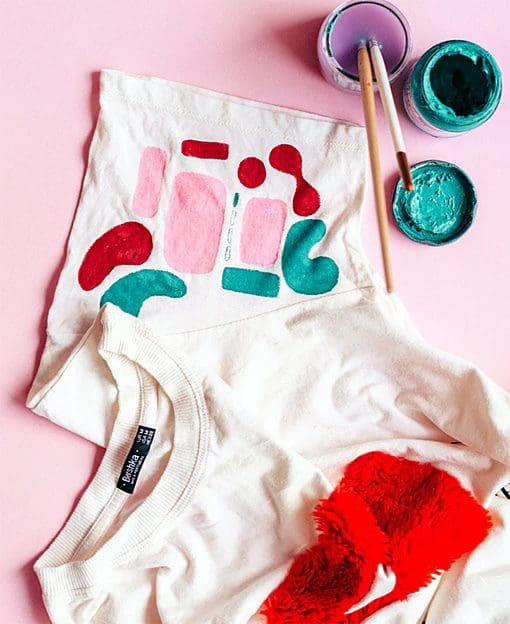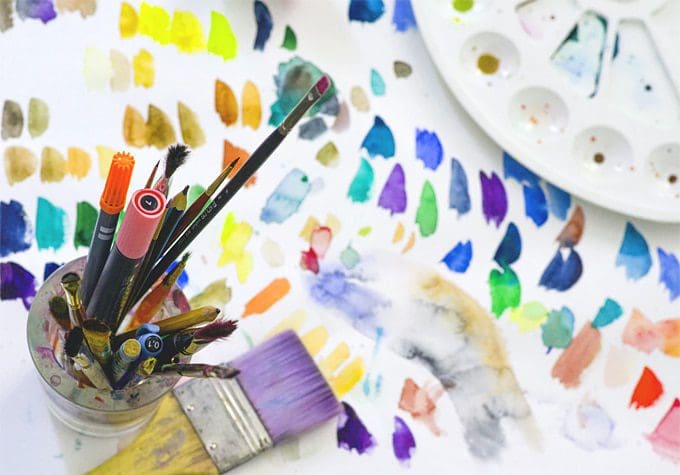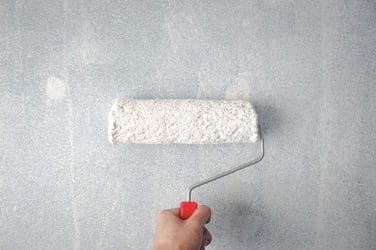words Alexa Wang

Fabric painting practices are techniques of using paints and brushes, markers or stencils to produce vibrant images and designs on textile.
You can make beautiful patterns, floral designs, geometric patterns and other prints with the aid of a brush and a few paints. Fabric painting can be done in any fabric but it is easier to work with tightly woven natural fabrics like cotton and silk.
We will further discuss in this writing some beginner’s guide to fabric painting, which has become very popular nowadays.
Paint for fabric painting
Acrylic oil paints beautifully along with every fabric. Acrylic fabric paint or textile paint should be typically used as it consists of pigment suspended in a specially formulated acrylic medium for use on fabric. You can also use all purpose acrylic paint for hand painting on given fabric, you just have to add fabric medium to it, to make it ideal for fabric painting. Fabric medium is a thick solvent that appears opaque when wet but dries colorless. Ordinary acrylic paint dries hard on the fabric surface and can crack after it dries but the medium makes it more malevolent or flexible. The medium is mixed up to 2 parts of acrylic paint in a proportion of 1 part of fabric then mixed well before using. Poster paint may also be used on cloth, but be careful, over time it can start to flake off. The fabric medium can also be used along with Acrylic fabric paint. It can be used to dilute paint of acrylic fabric without altering the colour with less bleeding by using the medium in place of water. Moreover, if you don’t like the glossy look, there is a matte medium that creates a matte effect when added to acrylic paint. If you prefer a spray paint, you should use a special medium to make the paint sprayable and prevent the sprayer from clogging.
Tools to use
Some of the most popular fabric painting techniques is to use a paintbrush to apply paint to a fabric much as one would do on paper. However, you may find it difficult to apply traditional brush techniques to your textile piece because the fabric is more complicated than a canvas or cardboard. It is recommended that you draw your design with a pencil on to your fabric before you are to paint, especially for beginner artists. Practice your pencil techniques by sketching your idea out on paper before you take on the fabric. Some people think that stenciling or transferring the design to the fabric beforehand can be useful when trying to draw intricate designs. Once you are pleased with your design you can start using paint to follow the drawing. It therefore gives you better guidance and lowers your chance of unresolvable mistakes. Fabric painting allows you to customize clothing, wearable textiles and upholstery fabrics as well as other items. According to the experts at haberdashery, It is beneficial to have online resources where you can get items needed for fabric painting with just one click. Drawstring lacing, buttons, piping cords and others that you can use to craft, embellish and transform your fabrics. There really is no barrier to how far you can go on the thrilling journey of turning simple items into personalized pieces of art and make your project more stunning.
Fabric Painting Techniques
Always take less paint than you think you need on the brush when painting. It is possible to increase darkness but it is impossible to decrease the color of the paint. You can do fabric painting almost exactly the same way you paint on canvas; layers on layers to build dimensions. There are also other techniques that produce a fantastic painted effect on textiles using fabric paint. Fabric painting is a good project that enables you to be flexible with your creativity and make use of your own ideas and artistic imagination to control your own designs. Before working on any textiles make sure they are clean and washed thoroughly. Iron any creases as it could be a disaster, put a piece of card under your selected material before painting to ensure smooth lines and prevent paint from flowing over to the other side. The mixing of colors is also wonderful. You will be amazed at the color spectrum you get by combining one or two basic colors in various proportions.

Artwork does not begin and end with canvas and paper, or with portraits and landscapes. In reality, wherever you want you can take your passion for art and crafting skills. You can even use fabric painting to transform clothing into trendy forms of self-expression and upgrade your old pants, bags, even furniture through painting. There are no rules here so have an imaginative mind and see where your creativity will take you!









